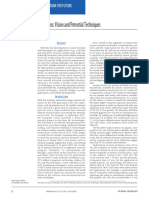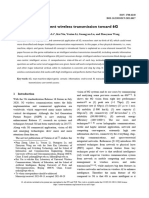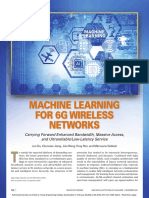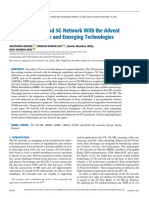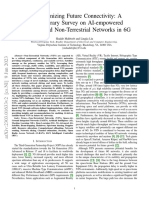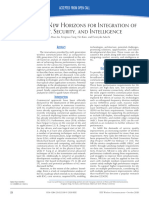NOMA - D2D - Cognitive Radio - 6G 2020
NOMA - D2D - Cognitive Radio - 6G 2020
Uploaded by
salahberraCopyright:
Available Formats
NOMA - D2D - Cognitive Radio - 6G 2020
NOMA - D2D - Cognitive Radio - 6G 2020
Uploaded by
salahberraCopyright
Available Formats
Share this document
Did you find this document useful?
Is this content inappropriate?
Copyright:
Available Formats
NOMA - D2D - Cognitive Radio - 6G 2020
NOMA - D2D - Cognitive Radio - 6G 2020
Uploaded by
salahberraCopyright:
Available Formats
ACCEPTED FROM OPEN CALL
Envisioning Device-to-Device Communications in 6G
Shangwei Zhang, Jiajia Liu, Hongzhi Guo, Mingping Qi, and Nei Kato
Abstract tecture at least has the following characteristics:
space-air-terrestrial-sea integrated (SATSI), artificial
To fulfill the requirements of various emerg- intelligence (AI) driven, higher frequency bands,
ing applications, the future sixth generation (6G) ultradense heterogeneous, green energy, security
mobile network is expected to be an innately intel- and privacy. For the sake of ubiquitous connec-
ligent, highly dynamic, ultradense heterogeneous tion, SATSI network architecture will enable flexible
network that interconnects all things with extreme- and efficient connection of trillion-level objects in
ly low-latency and high speed data transmission. It terrestrial, aerial, space, and sea domains. To main-
is believed that artificial intelligence (AI) will be the tain network systems with ultra high data rate and
most innovative technique that can achieve intelli- extraordinarily low latency, 6G will utilize much
gent automated network operations, management broader frequency bands, including sub-terahertz
and maintenance in future complex 6G networks. and terahertz (THz) bands as well as visible light
Driven by AI techniques, device-to-device (D2D) communication (VLC). Since higher frequency
communication will be one of the pieces of the 6G bands inevitably suffer from high path-loss, the data
jigsaw puzzle. To construct an efficient implemen- transmission distance will become much shorter.
tation of intelligent D2D in future 6G, we outline As a result, the 6G network will become extremely
a number of potential D2D solutions associating dense. Moreover, high-speed and low-latency D2D
with 6G in terms of mobile edge computing, net- communication and ultra-massive MIMO commu-
work slicing, and non-orthogonal multiple access nication will be the indispensable part of 6G net-
(NOMA) cognitive networking. works to cope with the limited distance. Therefore,
ultradense heterogenous networks are considered
Introduction to be one of the key components of 6G.
The wireless communication system has been devel- Although 5G has benefited greatly from ultra-
oped and regenerated for almost every decade to dense networks and device-to-device (D2D) com-
meet the ever-increasing network requirements. munication, further network densification in 6G
Until now, 5G has already been standardized in will encounter many serious problems and chal-
2018 and its commercial deployment was rolled lenges [3], like severe interference, very complex
out at the end of 2019. However, it is envisioned resource management, a vast amount of signaling,
that 5G cannot fulfill the requirements of emerging prohibitively high cost and energy consumption.
Internet of Everything applications like augmented Toward this end, researchers have pointed out that
reality (AR), virtual reality (VR), and mixed reality the utilization of AI techniques can help network
(MR), which require a convergence of communica- operators to realize intelligent automated network
tion, sensing, control, and computing functionalities operation, management and maintenance [4]. It is
[1]. In addition, new services, such as holographic believed that AI will be the most innovative tech-
communications, high-precision manufacturing, sus- nique for 6G [5]. By sensing and network big data
tainable development and smart environments, and training, AI techniques like machine learning (ML)
enhanced energy efficiency, cannot be efficient- will make complex 6G networks more intelligent
ly offered by the current development of 5G net- and can achieve a high level of efficient network
works. To fulfill such challenging requirements management and optimization, such as network
mentioned above, a novel network architecture of environment sensing, status predicting, proactive
the future sixth generation (6G) mobile network configuring, dynamic optimizing, self-healing, etc.
is required. To date, debates on 6G have already AI will gradually migrate from cloud to network
been carried out in many countries and organiza- edge, wherein multi-level AI will be employed [6].
tions. It might be too early to give an exact defini- It is noted that mobile user equipments (UEs)
tion of 6G, nevertheless, most researchers agree like smartphones are becoming more and more
that 6G will be an innately intelligent, highly dynam- powerful since they are integrated with power-
ic, extremely heterogeneous and ultradense net- ful high-end processors, rich storage resources,
work that interconnects all things. More concretely, long battery lifetime, multiple sensors, etc. They
6G is expected to support a data rate that is 100 to can be regarded as personal mobile workstations
1000 times faster than 5G (i.e., 1Tbps) with end-to- that enable light-level on-device AI processing
end latency less than 1 msec [2]. for intelligent networking in the future [2]. Many
Based on the existing 5G architecture, current researchers have pointed out that the utilization
research trends have shown that 6G network archi- of on-device AI can dynamically sense local net-
Shangwei Zhang, Jiajia Liu, Hongzhi Guo and Mingping Qi are with National Engineering Laboratory for Integrated Aero-Space-Ground-Ocean Big Data
Digital Object Identifier: Application Technology, Northwestern Polytechnical University, Xi’an, Shaanxi, P.R.China (Jiajia Liu is the corresponding author).
10.1109/MNET.001.1900652 Nei Kato is with the Graduate School of Information Sciences, Tohoku University.
86 0890-8044/20/$25.00 © 2020 IEEE IEEE Network • May/June 2020
Authorized licensed use limited to: Egyptian Knowledge Bank. Downloaded on February 10,2021 at 12:33:24 UTC from IEEE Xplore. Restrictions apply.
Full-Frequency Radio Access
300MHz 30GHz 300GHz 3THz 300THz 400THz 790THz
Radio/TV Microwave mmWave THz Wave IR UV
Intra-Plane
kHz MHz GHz THz
Two-Hop D2D D2D Clustering
Global Coverage Space-Air-Terrestrial-Sea
Integrated Networks
Fast Accurate
Beamforming
Core Intra-Ship D2D
Cloud
Edge
Internet IR
AI
NFV SDN
Technical Objectives of 6G
Peak Data Rate (≥ 1Tbps) Energy Efficiency (100×)
Latency (≤ 1msec) Network Density (107 Nodes/km2)
Mobility (≥1000km/h) Area Traffic Capacity 1Gbps/m2
Average Data Rate (1Gbps) Spectrum Efficiency (5-10×)
Data Training
Local Full
AI Center Application
Feature
Scalable
Extraction
On-Device Machine Learning AR/VR/MR High Precision Manufacturing M2M/D2D (Smart Home/Healthcare)
FIGURE 1. The D2D communications in future space-air-terrestrial-sea integrated 6G network.
work environment, efficiently and optimally adjust cal network and underwater acoustic network that
network parameters to meet different network provide wireless connections to those equipments
application requirements. over the sea and underwater area. It is believed that
Employing AI in D2D will lead to new oppor- terrestrial network will still be the most important
tunities and challenges in future 6G networks. As part for providing wireless mobile services for most
motivated by the aforementioned studies, we in human activities [8].
this paper envision a number of potential intelli- The SATSI network can make full use of the
gent D2D solutions associating with 6G in terms characteristics of global network coverage, full-fre-
of intelligent mobile edge computing (MEC), net- quency radio transmission and full application to
work slicing as well as non-orthogonal multiple achieve seamless high-speed communication in
access (NOMA) cognitive networking. space, air, terrestrial and sea domains, such as
automated driving, high precision manufacturing,
Architectures and Developing Trends of smart home/healthcare, AR, VR, MR, etc. With
6G Networks the participation of AI techniques, D2D commu-
nication will be employed to support low latency
Space-Air-Terrestrial-Sea Integrated Networks and high speed data transmission in different net-
Note that relying only on current terrestrial networks work scenarios, such as intra-plane two-hop D2D,
cannot fulfill the requirements of extremely broad intra-ship multi-hop D2D, D2D with fast accurate
coverage and ubiquitous connectivity. Therefore, beamforming in vehicular networks. In future 6G,
6G will further integrate sea/underwater networks massive D2D clusters will exist in local area due
with respect to 5G space-air-terrestrial networks, to the aggregation and social behavior of human
so as to support various applications and maintain beings. Users in each D2D cluster can be man-
ubiquitous mobile ultrabroadband everywhere. As aged and served via D2D connection.
shown in Fig. 1, a typical 6G SATSI network con-
tains four parts: a space network composed of Extremely Heterogeneous and Ultradense
interconnected satellites with different orbits; an air Terrestrial Networks
network containing a high altitude platform like an As wireless transmission distance will become
airplane [7], air ship, and low altitude unmanned much shorter in 6G, D2D communication is envi-
aerial vehicle (UAV) and flying base stations (BSs); sioned to continuously evolve into the 6G wireless
a heterogeneous ultradense terrestrial network communication systems to efficiently support a
that includes the core network (CN), cloud, edge, much larger and more diverse set of UEs and appli-
and M2M communication networks; a sea-based cations. Ultradense network integrated with D2D
network that contains shortwave communication, communication is considered as one of the pieces
ultrashort-wave communication, submarine opti- of the 6G jigsaw puzzle, making 6G terrestrial net-
IEEE Network • May/June 2020 87
Authorized licensed use limited to: Egyptian Knowledge Bank. Downloaded on February 10,2021 at 12:33:24 UTC from IEEE Xplore. Restrictions apply.
Access System Frequency Band Network Transmission Achievable Application
Mode type Range Rate scenarios
2G 890-960MHz GSM 35km 270.83kb/s Macro Cell
3G 1.94-2.145GHz WCDMA 10km 5.75-14.4Mb/s Macro Cell
4G 0.7-3.6GHz LTE/LTE-A 1-5km up to 1Gb/s Macro Cell
5G 30-300GHz mmWave < 1km multiple Gb/s Massive MIMO, Macro/Pico Cell
Licensed 6G 0.3-3THz THz wave < 1km up to 1Tb/s Small Cell
Band
WMAN 2.3-3.6GHz WiMax 50km around 100Mb/s Macro Cell
IoT 0.703-2.2GHz NB-IoT < 10km 160-250kb/s M2M
0.3-4GHz (UHF) L/S GEO/LEO up to 10Mb/s Space-air/ground/sea,
Satellite 4-30GHz (SHF) C/X/Ku/K/Ka GEO/MEO/LEO up to 1Gb/s Inter-Satellites, GNSS,
30-75GHz (EHF) Ka/Q/U/V MEO/LEO multiple Gb/s Feeder Link
2.4GHz,5GHz WiFi around 120m 11-600Mb/s Pico/Femto Cell, UAV
WLAN/WPAN 2.4-2.4835GHz Bluetooth 100m around 1Mb/s M2M
430-790THz Visible Light < 100m (LOS) up to multiple Gb/s Micro Cell
Unlicensed
Band 0.125-13.56MHz RFID/NFC 10cm 1-424kb/s M2M
IOT 300-400THz IrDA 10m around 4Mb/s M2M
5.85-5.925GHz DSRC (IoV) around 1km around 27Mb/s V2V, V2I, V2R, V2P
TABLE 1. Frequency resources available for D2D communications.
work inevitably be an ultradense heterogeneous work, while the local AI center can be embed-
network structure. Note that further network den- ded into traditional MBSs or MEC servers so as
sification will lead to performance degradation due to provide AI proceeding on local network man-
to the severe interference, prohibitively high cost agement. Note that UEs like smart phones may
and energy consumption [3]. Ultradense networks provide opportunities for on-device data training,
may lead to frequent handover for high speed which can sense and learn from the local channel
moving UEs. As THz bands signal has very strong pattern, traffic pattern, moving trajectory, etc.,
directional characteristics, the transmitter beam to understand the features of user behavior and
should perfectly point to the receiver antenna to predict the network status. In future 6G, global
successfully deliver the information, which makes AI, local AI and on-device AI will cooperate and
the network management a very challenging task. leverage one another’s advantages to maintain
Accordingly, emerging new interference manage- the network operation and optimization.
ment approaches, channel allocation scheme as
well as spectral efficiency are still essential in 6G
ultradense heterogeneous networks. Considering
Evolution of Terminal User Equipment in 6G
the frequent handover, interference and energy From Mobile Phone to Mobile Workstation
consumption problem in 6G ultradense network, Considering the growth of computational power
D2D and NOMA based communication could be provided by Moore’s law and future 6G commu-
one feasible solution in future. nication requirements, it can be seen that UEs
will equipped with powerful high-end processors,
Innately Intelligent and Highly Dynamic Network extraordinary rich storage resources, plenty of
As 6G network will be much more complex sensors and ultra-long lifetime batteries (ideally
and dynamic than the preceding generations of unlimited). Combined with breakthrough bat-
wireless networks, traditional network manage- tery technologies and intelligent operating sys-
ment methods will become untenable. Hence, tems, the power of such UE can be equivalent
intelligent network management and optimiza- to a mobile computer workstation with immense
tion approaches shall be employed to fulfill the computational power, high-speed data process-
different QoS demands. Over the past decade, ing and networking capability. We envision that
many types of ML algorithms [5], like super- future UEs will be designed as a type of hand-
vised learning, unsupervised learning, reinforce- held mobile computer workstation that can per-
ment learning, etc., were adopted for intelligent form intense processes like machine learning,
resource allocation, network optimization, small environment sensing, holography processing, AR/
BSs or UAVs deployment, network design, etc. VR cloud gaming and photonic computing, while
It is believed that AI-enabled radio access and keeping the same thin and portable designs as a
core networks will allow future networks to sense phone. Moreover, future UEs will be embedded
and learn from the environment, make decisions with multiple radio interfaces with full frequency
through big data training, automatically predict radio access capability that can connect to various
and adapt the network changes, and achieve opti- network systems with different QoS requirements.
mal performance by self-configuration. Table I summarizes the frequency resources avail-
It is envisioned that multi-level distributed AI able for D2D communications [9]–[11]. One can
will be employed to provide global intelligent see from Fig. 2 that future UEs can either connect
management of 6G networks. Specifically, the to the nearby devices via short range communica-
global AI center will be deployed in the core net- tion technologies or establish long range links via
88 IEEE Network • May/June 2020
Authorized licensed use limited to: Egyptian Knowledge Bank. Downloaded on February 10,2021 at 12:33:24 UTC from IEEE Xplore. Restrictions apply.
satellite communications, thus ensuring the ubiq- On-device Machine Learning Environment Sensing
uitous connection from anywhere at any time. Health Skills y
Community
Equipped with plenty of sensors and powerful
processors, future UEs have the real time collection
capability for mapping and sensing the world, such
Spectrum Speed Weather Wind
as environment sensing and wireless reality sensing.
As higher frequency bands will be exploited in 6G,
the antenna size on these spectrum bands can be
so small that multiple antennas can be easily embed- S i li i
Socializing Location
ded in small size UEs or even in smaller IoT devices
which may take advantage of the merits of MIMO
technologies [12]. Moreover, THz will enable new
sensing applications in multiple domains like security Message Hobby Trail Wireless Reality Sensing
sensing, gesture detection, body scanning, health-
care monitoring, and 3D mapping and imaging. Distributed Machine Learning 3D Full-Frequency Radio Access
Imaging LoRA C/Ku/Ka bands DSRC
From Smart Mobile Phone to AI-Driven Mobile Phone Global AI Center Model
The growing computation and storage power of Training
devices can achieve on-device AI by local data
training. According to [11], smart phones will have Feedback
computational capabilities that are on the order Local model
of the human brain in the near future. Due to the Inte
Intelligent
update Radio
R Bluetooth
IrDA
employment of higher frequency bands, UEs may Feedback
be equipped with multiple antennas and support
full duplex transmission, high speed data transmis- On-device
sion, a large volume of data caching, MIMO com- model update
munication, cognitive and sensing ability. All the Local AI Center THz band VLC mmWave
above characteristics enable UEs to have AI ability
to perform on-device ML so as to predict moving FIGURE 2. Illustration of the intelligent user equipment in 6G.
trace, common interest content, sensing local envi-
ronment, etc. Therefore, mobile phones in 6G will is an effective way to enhance the network edge
shift from smart phones to AI-driven phones. computing. As shown in Fig. 3, each UE in this
Driven by on-device AI techniques, future mobile architecture has a certain scale of computing and
phones will be designed not only for personal use, communication capability and can proceed task
but also for intelligent networking. It helps to enable executions when being idle. As the capability of
proactive 6G network management and automated single UE is relatively weak, computational inten-
network configuration, thus to improve quality of sive tasks may inevitably be allocated to multiple
experience (QoE) and quality of service (QoS) for UEs. Fortunately, the utilization of THz band D2D
network services. However, relying solely on on-de- communication would make the computing down-
vice AI is far from enough to predict and manage loading and uploading between two close UEs near-
the large domain dynamic networks. Local AI will real-time. Thus, we envision future 6G will employ
be employed for local network data training, so as the capacity of D2D clusters for edge computing.
to intelligently utilize the collaboration among edge The key and difficult point to employ D2D-en-
UEs and the local AI center to exchange the learn- hanced MEC lies in the optimal management and
ing parameters for a better training and inference allocation of network communication and compu-
of the models. In terms of data privacy and security, tation resources. We envision that AI techniques
federated learning, which can keep data training at will be employed to make the resource allocation
each UE, will be employed to learn a shared global and optimization intelligent. As illustrated in Fig. 3,
model from edge UEs. each edge server combines local AI and MEC serv-
er together to intelligently provide services to local
AI-Driven D2D Communication in 6G edge UEs. The local AI can be the central server
The key feature of D2D communication in 6G is to for coordinating the local resource of UEs or D2D
leverage the shared information from the local and clusters. By merging the uploaded on-device AI
on-device AI to extend UEs’ view scope and increase training data from UEs, local AI can intelligently
their awareness of the local network environment. To manage network resources, including sensing and
construct an efficient implementation of intelligent predicting available dynamic D2D clusters’ resourc-
D2D in future 6G networks, we forecast that at least es, optimizing and balancing the resource of the
the following key techniques should be developed. whole MEC systems, making decisions on task allo-
cation. For instance, if the capability of a single UE
Intelligent D2D-Enhanced Mobile Edge Computing cannot support a computation-intensive task, then
The ever-increasing demand in data traffic and com- the local AI will allocate the task to local D2D clus-
putation imposes a huge amount of workload on ters via D2D or cellular links. If both UEs and D2D
cloud and MEC servers. Relying only on the joint clusters fail to support the tasks, then the tasks will
cloud and MEC paradigm cannot fulfill the QoE be allocated to edge or cloud servers with more
requirements of UEs. Note that the computation powerful computing capability [13].
and storage resources of UEs are far from the
requirement of users. Additionally, the end-to-end D2D-Enabled Intelligent Network Slicing
transmission time will be greatly reduced due to the In 5G, a network slice (NS) is a basic substrate
extremely high data rate in 6G, resulting in lots of offered by public land mobile network (PLMN) which
idle UEs. To make full use of the spare resources is supplied by mobile network operators or infrastruc-
IEEE Network • May/June 2020 89
Authorized licensed use limited to: Egyptian Knowledge Bank. Downloaded on February 10,2021 at 12:33:24 UTC from IEEE Xplore. Restrictions apply.
intelligent service to resource mapping. By intelli-
Global Intelligent Task Scheduling
gently stitching physical network functions (PNFs)
AI/Cloud Task Sequence and VNFs, the federated network slice instance can
Center be efficiently created and/or dynamically adjusted
Task Allocation to fulfill diverse service requirements without nega-
Core tively affecting other slice instances.
Network
To UE
D2D Link NOMA and D2D Based Cognitive Networking
Local As an emerging multiple-access technique,
AI/MEC Cooperation NOMA can be integrated into cognitive radio
Servers To D2D Cluster networks (CRNs) to improve spectrum efficien-
D2D/Cellular Link cy, user fairness and connectivity density. By
employing NOMA, secondary UEs can efficiently
Access Upload cooperate with primary UEs to obtain spectrum
Points To Edge Server
D2D/Cellular Link access opportunities. Apart from CRNs, combin-
ing NOMA with D2D allows one D2D transmit-
ter to communicate with several D2D receivers
Edge via NOMA, so as to achieve better D2D perfor-
D2D To Cloud
UEs
Cluster D2D/Cellular Link mance gains. Under this circumstance, D2D users
are clustered not only according to the aggrega-
Idle UE Busy UE AI Training Data Resources tion and social behavior of human beings, but
also through the NOMA way. As shown in Fig.
FIGURE 3. Illustration of D2D-enhanced mobile edge computing. By merging 5, D2D-aided cooperative NOMA is employed
the uploaded on-device AI training data from UEs, local AI can intelligently in primary networks by selecting proper UEs as
offload tasks to D2D clusters via D2D or cellular links for edge computing. NOMA relays that establish D2D connections to
UEs in the nearby NOMA groups. With the help
of Local AI and on-device AI, NOMA relays can
ture providers. Network resources owned by private be intelligently chosen by utilizing techniques like
third-party actors outside of operator infrastructures wireless cognition, intelligent user pairing, channel
can also be involved for network slicing [14]. Note estimation, and hyper-accurate position location.
that a large number of dynamic D2D clusters can pro- In secondary networks, UEs in each cluster are
vide physical and/or virtual infrastructure resources, intelligently managed and served via NOMA, while
such as computation, network, memory, and storage, different D2D clusters employ orthogonal multiple
which may give rise to a proliferation of resources access (OMA) for simultaneously communicating.
at the network edge. In Fig. 4, we envision that the Engineers will encounter many challenges when
D2D enabled intelligent network slicing approach employing NOMA in D2D, such as complex pre-
will help network operators to efficiently federate and coding mechanism in each NOMA group and
integrate network resources including PLMN, private co-channel interference management among UEs in
third party and D2D clusters at the network edge. the same subchannel. To this end, accurate beam-
Different from PLMN and third party, the formation forming based on intelligent channel estimation and
of D2D clusters are highly dynamic and opportunis- dynamic precoding techniques will be employed to
tic, making network slicing a very challenging task. compensate for the additional power requirements
Accordingly, multi-level AI including global AI, local that are caused by the increased interference and
AI and on-device AI, will be used for discovering and noise. Recently, the concept of delta-OMA (D-OMA)
managing a large number of D2D clusters, thus to technique has been proposed for large scale concur-
proceed real-time dynamic network slicing. rent access in 6G [15]. Although designed for cellular
Specifically, there exists an integration layer networks, D-OMA will be employed for D2D clusters
wherein multi-level AI will be employed for real- in secondary networks to further improve network
time resource sensing and predicting to discover performance via accurate beamforming. The accu-
the dynamic resources that are candidates to be rate beamforming can be achieved by utilizing mul-
integrated. By merging the updates of on-device tiple narrow beamwidth antennas or high frequency
AI models from UEs and exchanging the learn- bands signal with strong directional characteristics.
ing parameters, local AI can predict and provide It can result in a highly dominant line-of.sight (LOS)
real-time views of dynamic resource information, component which is much stronger than the non-
including available infrastructure resources and LOS (NLOS) paths. The highly correlated channels
localization of available D2D clusters. As infrastruc- at higher frequencies will make the use of D-OMA
ture resources may come from different provid- more attractive at higher frequencies.
ers or stretch across greater geographical areas,
AI techniques are also employed for intelligent Conclusion
resource aggregating and evaluating, as well as We have envisioned in this article the D2D com-
configuring and monitoring, thus to establish logical munications in future 6G. Based on the developing
interconnection of the dynamic physical resourc- trend of potential 6G architecture and the evolu-
es for operators. Then, the virtualization layer tion of future terminal user equipment, we focus
abstracts and decouples the physical resources in our attention on conducting efficient implemen-
terms of virtual network functions (VNFs). With the tation of intelligent D2D in future 6G communi-
help of multi-level AI, intelligent management and cation systems, including D2D-enhanced mobile
orchestration of virtual resources can be achieved edge computing, D2D-enabled intelligent network
by monitoring and evaluating the status of underly- slicing, and NOMA and D2D based cognitive net-
ing resource and network slices, as well as predict- working. We hope our discussion will serve as a
ing the requirements of upcoming services through guideline for future D2D development in 6G.
90 IEEE Network • May/June 2020
Authorized licensed use limited to: Egyptian Knowledge Bank. Downloaded on February 10,2021 at 12:33:24 UTC from IEEE Xplore. Restrictions apply.
Acknowledgment Intelligent Service to
This work was supported by the National Natural Sci- Network Resource Mapping
Network Slice Instances
ence Foundation of China (61771374, 61771373,
Slice
61801360, and 61601357); and in part by the Fun- Instance Network Slice Functions
damental Research Fund for the Central Universities Layer Data Plane
(3102019PY005, and 310201905200001). Intelligent Stitching
Control Plane
References
[1] J. Liu et al., “Device-to-Device Communication in LTE-Ad- Intelligent
vanced Networks: A Survey,” IEEE Commun. Surveys Tuts., Virtual Virtual Virtual Virtual Management and
vol. 17, no. 4, 2015, pp. 1923–40. Resources Computing Storage Network Orchestration
[2] K. B. Letaief et al., “The Roadmap to 6G: AI Empowered
Wireless Networks,” IEEE Commun. Mag., vol. 57, no. 8,
Aug. 2019, pp. 84–90. Virtualization SDN
Layer NFV Intelligent Resource
[3] K. David et al., “Defining 6G: Challenges and Opportunities
[from the guest editors],” IEEE Veh. Tech. Mag., vol. 14, no. Sensing, Predicting
3, Sept. 2019, pp. 14–16. Integration AI-Enabled Resource AI-Enabled Resource
and Discovering
[4] W. Xu et al., “Intelligent Link Adaptation in 802.11 Vehicular Layer Aggregation and Evaluation Configuring and Monitoring
Networks: Challenges and Solutions,” IEEE Commun. Stand.
Mag., vol. 3, no. 1, 2019, pp. 12–18.
AI
[5] M. Elsayed and M. Erol-Kantarci, “AI-Enabled Future Wireless Global AI
Networks: Challenges, Opportunities, and Open Issues,”
IEEE Veh. Tech. Mag., vol. 14, no. 3, Sept. 2019, pp. 70–77. Physical Stadium
[6] B. Zong et al., “6G Technologies: Key Drivers, Core Require- Layer Edge Local AI
ments, System Architectures, and Enabling Technologies,” 6G Core cloud
IEEE Veh. Tech. Mag., vol. 14, no. 3, Sept. 2019, pp. 18– 27. Network 6G RAN Mall D2D Cluster
[7] X. Huang et al., “Airplane-Aided Integrated Networking for Public Land Mobile Network Third Party End UEs On-Device AI
6G Wireless: Will it Work?” IEEE Veh. Tech. Mag., vol. 14, no.
3, Sept. 2019, pp. 84–91.
[8] Z. Zhang et al., “6G Wireless Networks: Vision, Require- FIGURE 4. Illustration of D2D-enabled intelligent network slicing structure, where-
ments, Architecture, and Key Technologies,” IEEE Veh. Tech.
Mag., vol. 14, no. 3, Sept. 2019, pp. 28–41.
in multi-level AI will be used for federating and integrating network resourc-
[9] M. L. Roberts et al., “Evolution of the Air Interface of Cellu- es provided by a large number of dynamic D2D clusters.
lar Communications Systems toward 4G Realization,” IEEE
Commun. Surveys Tuts., vol. 8, no. 1, 2006, pp. 2–23. D2D-Aided
[10] R. Radhakrishnan et al., “Survey of Inter-Satellite Communi- Cooperative NOMA
cation for Small Satellite Systems: Physical Layer to Network (Primary Networks)
Layer View,” IEEE Commun. Surveys Tuts., vol. 18, no. 4,
2016, pp. 2442–2473.
[11] T. S. Rappaport et al., “Wireless Communications and Appli-
cations above 100 GHz: Opportunities and Challenges for 6G Hyper-Accurate
and Beyond,” IEEE Access, vol. 7, Jun. 2019, pp. 78 729–78 757. Position Location NOMA
[12] F. Zhou et al., “State of the Art, Taxonomy, and Open
Issues on Cognitive Radio Networks with NOMA,” IEEE Intelligent
Wireless Commun., vol. 25, no. 2, Apr. 2018, pp. 100–08. NOMA User Pairing
[13] F. Tang et al., “Future Intelligent and Secure Vehicular Net-
work towards 6G: Machine Learning Approaches,” Proc.
IEEE, DOI:10.1109/JPROC.2019.2954595. Intelligent
[14] H. Khelifi et al., “Bringing Deep Learning at the Edge of Channel Estimation
Information-Centric Internet of Things,” IEEE Commun. Lett., Beamwidth Selection
vol. 23, no. 1, Jan. 2019, pp. 52–55.
[15] Y. Al-Eryani and E. Hossain, “The D-OMA Method for Massive
Multiple Access in 6G: Performance, Security, and Challenges,” UE4
D-OMA U
UE5
IEEE Veh. Tech. Mag., vol. 14, no. 3, Sept. 2019, pp. 92–99.
Biographies Accurate
Beamforming
Shangwei Zhang (S’15-M’20) received his B.S., M.S., and Ph.D. D-OMA UE7
degrees in computer science and technology from Xidian Univer- Dynamic UE6
sity in 2007, 2011, and 2019, respectively. He is currently an asso- UE
UE3
Precoding
ciate professor with the School of Cybersecurity, Northwestern
Polytechnical University. His research interests cover a wide range
Power Power
UE1
of areas including wireless and mobile ad hoc networks, space-air- UE2 UE3
ground integrated networks, D2D, MIMO, IoT, 5G, etc.
NOMA UE5 UE7
UE2
Jiajia Liu (S’11-M’12-SM’15) is currently a full professor with the NOMA/D-OMA Based UE1 UE4 UE6
School of Cybersecurity, Northwestern Polytechnical University. D2D Clustering Frequency
Frequency
His research interests cover wireless mobile communications, (Secondary Networks)
FiWi, IoT, etc. He has published more than 130 peer-reviewed NOMA D-OMA
papers in many prestigious IEEE journals and conferences, and
currently serves as an editor for IEEE Network, TWC, TVT, and
FIGURE 5. Illustration of the NOMA and D2D based cognitive networking.
TCCN, and as a guest editor for IEEE IoT Journal and TETC. He is
a Distinguished Lecturer of IEEE ComSoc. sity, China, in 2019. He is now working as an assistant professor
at Northwestern Polytechnical University. His research interests
Hongzhi Guo (S’07-M’16) received his B.S., M.S., and Ph.D. include public key cryptography especially ECC, cryptographic
degrees in computer science and technology from Harbin Insti- protocol and network security, etc.
tute of Technology in 2004, 2006, and 2011, respectively. He is
currently an associate professor with the School of Cybersecuri- Nei Kato (A03-M’04-SM’05-F13) is currently a full profes-
ty, Northwestern Polytechnical University. His research interests sor at GSIS, Tohoku University. He currently serves as the
cover a wide range of areas including MEC, AI, FiWi, IoT, 5G, Vice-President–Member & Global Activities for IEEE Com-
smart grid, etc. He has published more than 30 peer-reviewed Soc, Editor-in-Chief of IEEE Transactions on Vehicular Tech-
papers in many prestigious IEEE journals and conferences, and nology, and Associate Editor-in-Chief of the IEEE Internet of
currently serves as an editor for the International Journal of Mul- Things Journal. He has also served as the Chair of the SSC
timedia Intelligence and Security. and AHSN Technical Committees of IEEE ComSoc. He is a
Distinguished Lecturer of IEEE ComSoc and the Vehicular
Mingping Qi received his Ph.D. degree in applied mathematics Technology Society. He is a Fellow of The Engineering Acad-
from the School of Mathematics and Statistics of Wuhan Univer- emy of Japan and IEICE.
IEEE Network • May/June 2020 91
Authorized licensed use limited to: Egyptian Knowledge Bank. Downloaded on February 10,2021 at 12:33:24 UTC from IEEE Xplore. Restrictions apply.
You might also like
- Method Statement On Construction of Power Transformer Foundation at Bolawatta Grid Sub StationNo ratings yetMethod Statement On Construction of Power Transformer Foundation at Bolawatta Grid Sub Station2 pages
- Blockchain-Based Data Security For Artificial Intelligence Applications in 6G NetworksNo ratings yetBlockchain-Based Data Security For Artificial Intelligence Applications in 6G Networks7 pages
- Towards 6G Networks: Use Cases and TechnologiesNo ratings yetTowards 6G Networks: Use Cases and Technologies8 pages
- Several Key Technologies for 6G Challenges and OpportunitiesNo ratings yetSeveral Key Technologies for 6G Challenges and Opportunities8 pages
- A Survey of Promising Technologies in 6G: April 2020No ratings yetA Survey of Promising Technologies in 6G: April 20207 pages
- 6G Wireless Communications Vision and Potential TechniquesNo ratings yet6G Wireless Communications Vision and Potential Techniques6 pages
- Digital Twin and Artificial Intelligence For Intelligent Planning and Energy-Efficient Deployment of 6G Networks in Smart FactoriesNo ratings yetDigital Twin and Artificial Intelligence For Intelligent Planning and Energy-Efficient Deployment of 6G Networks in Smart Factories9 pages
- 4 - 6G Connectivity in The Era of Distributed IntelligenceNo ratings yet4 - 6G Connectivity in The Era of Distributed Intelligence8 pages
- Emerging Technologies of 6G over 5G (Autosaved) (Autosaved)No ratings yetEmerging Technologies of 6G over 5G (Autosaved) (Autosaved)6 pages
- A Vision of 6G Wireless Systems Applications, Trends, Technologies, and Open Research ProblemsNo ratings yetA Vision of 6G Wireless Systems Applications, Trends, Technologies, and Open Research Problems10 pages
- 6G Architecture to Connect the Worlds_NokiaNo ratings yet6G Architecture to Connect the Worlds_Nokia13 pages
- IEEE DP White Paper The Future of Telecom Engineering R1 BNo ratings yetIEEE DP White Paper The Future of Telecom Engineering R1 B11 pages
- 6G Technologies: Key Drivers, Core Requirements, System Architectures, and Enabling TechnologiesNo ratings yet6G Technologies: Key Drivers, Core Requirements, System Architectures, and Enabling Technologies10 pages
- Structured Satellite-UAV-Terrestrial Networks For 6G Internet of ThingsNo ratings yetStructured Satellite-UAV-Terrestrial Networks For 6G Internet of Things7 pages
- Transformation From 5G For Verticals Towards A 6GNo ratings yetTransformation From 5G For Verticals Towards A 6G6 pages
- An Intelligent Wireless Transmission Toward 6GNo ratings yetAn Intelligent Wireless Transmission Toward 6G14 pages
- Networked Twins and Twins of Networks: An Overview On The Relationship Between Digital Twins and 6GNo ratings yetNetworked Twins and Twins of Networks: An Overview On The Relationship Between Digital Twins and 6G8 pages
- Machine Learning For 6G Wireless NetworksNo ratings yetMachine Learning For 6G Wireless Networks13 pages
- A Vision of 6G Wireless Systems ApplicatNo ratings yetA Vision of 6G Wireless Systems Applicat9 pages
- Research Article Sixth Generation (6G) Cognitive Radio Network (CRN) Application, Requirements, Security Issues, and Key ChallengesNo ratings yetResearch Article Sixth Generation (6G) Cognitive Radio Network (CRN) Application, Requirements, Security Issues, and Key Challenges18 pages
- A Survey On Beyond 5G Network With The Advent of 6G Architecture and Emerging TechnologiesNo ratings yetA Survey On Beyond 5G Network With The Advent of 6G Architecture and Emerging Technologies36 pages
- 6G Wireless Communication Systems: Applications, Requirements, Technologies, Challenges, and Research DirectionsNo ratings yet6G Wireless Communication Systems: Applications, Requirements, Technologies, Challenges, and Research Directions19 pages
- AI-Native Network Slicing For 6G NetworksNo ratings yetAI-Native Network Slicing For 6G Networks8 pages
- Machine Learning For Physical Layer in 5G and BeyondNo ratings yetMachine Learning For Physical Layer in 5G and Beyond44 pages
- 8 - Enabling Technologies For Programmable and Software Defined RadioNo ratings yet8 - Enabling Technologies For Programmable and Software Defined Radio4 pages
- Machine Learning in 6G Wireless CommunicationsNo ratings yetMachine Learning in 6G Wireless Communications9 pages
- 6G Wireless Communication Systems: Applications, Requirements, Technologies, Challenges, and Research DirectionsNo ratings yet6G Wireless Communication Systems: Applications, Requirements, Technologies, Challenges, and Research Directions19 pages
- A-A DAG Blockchain Enhanced User-Autonomy Spectrum Sharing Framework for 6G-Enabled IoTNo ratings yetA-A DAG Blockchain Enhanced User-Autonomy Spectrum Sharing Framework for 6G-Enabled IoT12 pages
- 2022 6G Opening New Horizons For Integration of Comfort Security and IntelligenceNo ratings yet2022 6G Opening New Horizons For Integration of Comfort Security and Intelligence7 pages
- Application of 5G Next Generation Network To Internet of ThingsNo ratings yetApplication of 5G Next Generation Network To Internet of Things5 pages
- Machine Learning in Beyond 5G6G Networks-State-ofNo ratings yetMachine Learning in Beyond 5G6G Networks-State-of28 pages
- M.Tech - Computer Vision and Image ProcessingNo ratings yetM.Tech - Computer Vision and Image Processing21 pages
- GENEX U-NetV200R001 Product DescriptionNo ratings yetGENEX U-NetV200R001 Product Description22 pages
- Research Iv Quarter 1 Weeks 5-8: Not For SaleNo ratings yetResearch Iv Quarter 1 Weeks 5-8: Not For Sale7 pages
- BP2100G0_56662-03_56663-03_56664-03_97_BNo ratings yetBP2100G0_56662-03_56663-03_56664-03_97_B27 pages
- Kumax: (1000 V / 1500 V) Cs3U-335 - 340 - 345 - 350PNo ratings yetKumax: (1000 V / 1500 V) Cs3U-335 - 340 - 345 - 350P2 pages
- DS 20220523 SG6600UD-MV 8800UD-MV Datasheet V13 EN100% (1)DS 20220523 SG6600UD-MV 8800UD-MV Datasheet V13 EN2 pages
- Cyberark - Cau302.V2021-06-15.Q80: Leave A ReplyNo ratings yetCyberark - Cau302.V2021-06-15.Q80: Leave A Reply19 pages
- Netgear gs108 Commutateur Gigabit 8 PortsNo ratings yetNetgear gs108 Commutateur Gigabit 8 Ports2 pages
- Instant Download Database Systems Design Implementation Management 12th Edition Carlos Coronel PDF All Chapter100% (3)Instant Download Database Systems Design Implementation Management 12th Edition Carlos Coronel PDF All Chapter53 pages
- Football Manager 2021 Best Free PlayersNo ratings yetFootball Manager 2021 Best Free Players42 pages
- Method Statement On Construction of Power Transformer Foundation at Bolawatta Grid Sub StationMethod Statement On Construction of Power Transformer Foundation at Bolawatta Grid Sub Station
- Blockchain-Based Data Security For Artificial Intelligence Applications in 6G NetworksBlockchain-Based Data Security For Artificial Intelligence Applications in 6G Networks
- Several Key Technologies for 6G Challenges and OpportunitiesSeveral Key Technologies for 6G Challenges and Opportunities
- A Survey of Promising Technologies in 6G: April 2020A Survey of Promising Technologies in 6G: April 2020
- 6G Wireless Communications Vision and Potential Techniques6G Wireless Communications Vision and Potential Techniques
- Digital Twin and Artificial Intelligence For Intelligent Planning and Energy-Efficient Deployment of 6G Networks in Smart FactoriesDigital Twin and Artificial Intelligence For Intelligent Planning and Energy-Efficient Deployment of 6G Networks in Smart Factories
- 4 - 6G Connectivity in The Era of Distributed Intelligence4 - 6G Connectivity in The Era of Distributed Intelligence
- Emerging Technologies of 6G over 5G (Autosaved) (Autosaved)Emerging Technologies of 6G over 5G (Autosaved) (Autosaved)
- A Vision of 6G Wireless Systems Applications, Trends, Technologies, and Open Research ProblemsA Vision of 6G Wireless Systems Applications, Trends, Technologies, and Open Research Problems
- IEEE DP White Paper The Future of Telecom Engineering R1 BIEEE DP White Paper The Future of Telecom Engineering R1 B
- 6G Technologies: Key Drivers, Core Requirements, System Architectures, and Enabling Technologies6G Technologies: Key Drivers, Core Requirements, System Architectures, and Enabling Technologies
- Structured Satellite-UAV-Terrestrial Networks For 6G Internet of ThingsStructured Satellite-UAV-Terrestrial Networks For 6G Internet of Things
- Networked Twins and Twins of Networks: An Overview On The Relationship Between Digital Twins and 6GNetworked Twins and Twins of Networks: An Overview On The Relationship Between Digital Twins and 6G
- Research Article Sixth Generation (6G) Cognitive Radio Network (CRN) Application, Requirements, Security Issues, and Key ChallengesResearch Article Sixth Generation (6G) Cognitive Radio Network (CRN) Application, Requirements, Security Issues, and Key Challenges
- A Survey On Beyond 5G Network With The Advent of 6G Architecture and Emerging TechnologiesA Survey On Beyond 5G Network With The Advent of 6G Architecture and Emerging Technologies
- 6G Wireless Communication Systems: Applications, Requirements, Technologies, Challenges, and Research Directions6G Wireless Communication Systems: Applications, Requirements, Technologies, Challenges, and Research Directions
- Machine Learning For Physical Layer in 5G and BeyondMachine Learning For Physical Layer in 5G and Beyond
- 8 - Enabling Technologies For Programmable and Software Defined Radio8 - Enabling Technologies For Programmable and Software Defined Radio
- 6G Wireless Communication Systems: Applications, Requirements, Technologies, Challenges, and Research Directions6G Wireless Communication Systems: Applications, Requirements, Technologies, Challenges, and Research Directions
- A-A DAG Blockchain Enhanced User-Autonomy Spectrum Sharing Framework for 6G-Enabled IoTA-A DAG Blockchain Enhanced User-Autonomy Spectrum Sharing Framework for 6G-Enabled IoT
- 2022 6G Opening New Horizons For Integration of Comfort Security and Intelligence2022 6G Opening New Horizons For Integration of Comfort Security and Intelligence
- Application of 5G Next Generation Network To Internet of ThingsApplication of 5G Next Generation Network To Internet of Things
- Kumax: (1000 V / 1500 V) Cs3U-335 - 340 - 345 - 350PKumax: (1000 V / 1500 V) Cs3U-335 - 340 - 345 - 350P
- DS 20220523 SG6600UD-MV 8800UD-MV Datasheet V13 ENDS 20220523 SG6600UD-MV 8800UD-MV Datasheet V13 EN
- Instant Download Database Systems Design Implementation Management 12th Edition Carlos Coronel PDF All ChapterInstant Download Database Systems Design Implementation Management 12th Edition Carlos Coronel PDF All Chapter








